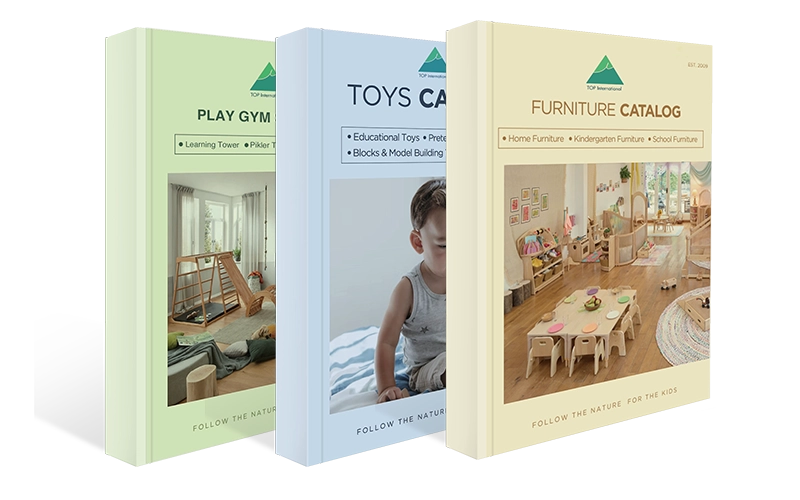Have you noticed your child playing next to other children, but not directly engaging with them? Is it concerning when toddlers seem more focused on their play rather than interacting with peers? Parallel play definition refers to when children play side by side, engaging in similar activities without interacting directly. It’s a sign of growing independence and social learning, not a concern about social development.
While this may feel like a sign of social isolation or a missed opportunity for interaction, it’s a common developmental phase many children go through. Parallel play, where children play side by side without direct interaction, might seem confusing or worrying. However, it’s a natural stage that serves as a foundation for future social skills. Parallel play is a key developmental stage that helps toddlers gain independence, observe social cues, and prepare for more interactive forms of play.
According to the Parallel Play Definition in early childhood development, this behavior is not just normal—it’s necessary. Please continue reading; understanding this concept will make you feel more confident in supporting your child’s natural social journey.
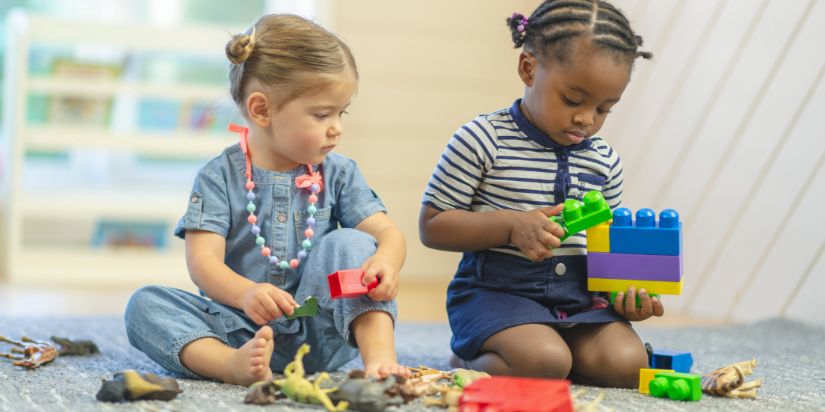
What is Parallel Play?
Parallel play is a stage in child development where two or more children play side by side without direct interaction. In this phase, children use similar toys or engage in similar activities but remain focused on their play rather than collaborating or interacting directly. This form of play usually occurs in children between the ages of 2 and 3, and is a regular part of early childhood development.
While parallel play does not involve direct social interaction, it plays a significant role in child development. At this stage, children learn essential skills such as independence, observation, and understanding the world around them. It’s critical to recognize that parallel play means children are not avoiding each other; they are simply developing the necessary skills to eventually engage in more interactive game forms, such as cooperative play.
Children engaged in parallel play often observe each other, learning new behaviors and social cues. This allows them to practice using toys in different ways, usually imitating the actions of their peers. Even though there’s no direct interaction, parallel play is the foundation for later social behaviors and is crucial for toddler parallel play development.

Why is Parallel Play Important in Child Development?
Understanding the benefits of parallel play can help you see how it supports the development of social, emotional, and cognitive skills. Although parallel play in early childhood may seem passive, it is crucial for helping children learn to navigate their environments. Here’s why it’s so important:
Independence and Autonomy
One key benefit of parallel play is that it promotes independence. As children engage in parallel play, they start deciding what to do and how to use the toys in front of them. They learn to enjoy their own company and feel empowered to take control of their activities. This process helps build self-esteem and confidence, which are essential for their overall development.
While children may not yet engage in complex cooperative play, parallel play allows them to develop a sense of self and autonomy. They gain confidence in their ability to play independently without needing constant interaction with others. This definition of parallel play—a space for independence—sets the stage for more advanced social interactions later.
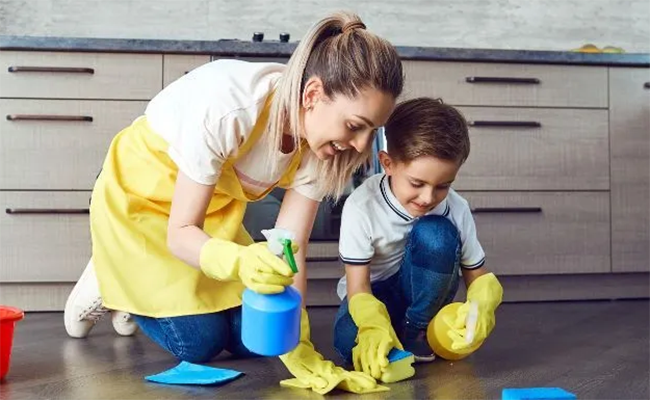
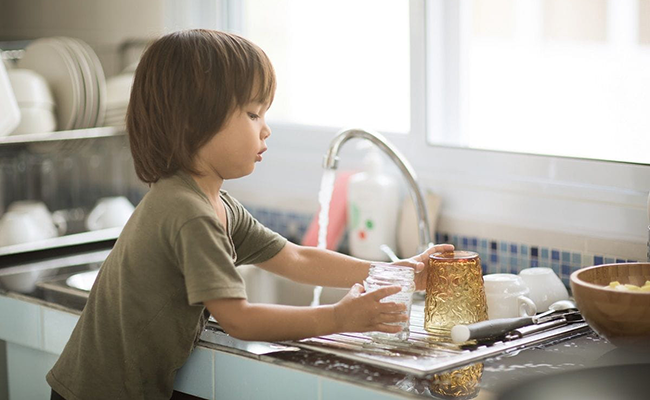
Observation and Imitation
Parallel play also provides a significant opportunity for observational learning. Children may not be directly playing together, but they closely observe one another. Through this parallel play, they consciously or unconsciously imitate actions, ideas, and behaviors.
For example, one child might build a structure with blocks, and another might start building a similar structure nearby, mimicking the action. This observational learning process helps children understand the importance of parallel play for gaining new knowledge. Through this interaction, though indirect, children start to learn basic social rules, such as taking turns, waiting, and respecting others’ space.

Preparation for Cooperative Play
As children grow older, parallel play gradually evolves into cooperative play. While parallel play in toddlers involves separate activities, these interactions often set the stage for children to start interacting with their peers. For instance, children who have practiced playing side by side usually transition to playing together by building a tower with blocks or engaging in simple games with rules.
Parallel play is essential in preparing children for cooperative play by providing a context for learning group behaviors, respecting boundaries, and recognizing shared space. Though they are not yet collaborating, they are slowly acquiring the necessary skills to engage in group play.
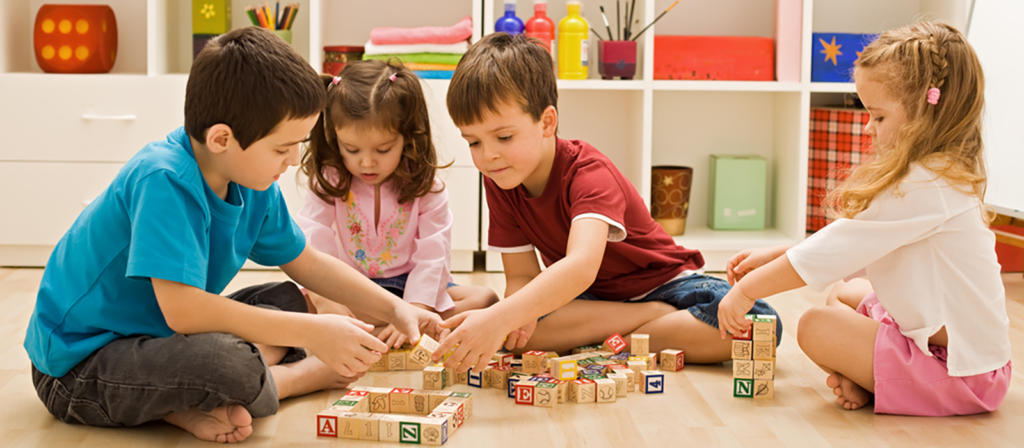
The Role of Parallel Play in Social Skills
Parallel play in child development helps children understand the subtleties of non-verbal communication. As they observe their peers’ body language and facial expressions, they learn to interpret emotions and gauge appropriate responses. These early lessons are essential for developing more complex social interactions later, as children will begin to recognize when someone is happy, sad, frustrated, or excited. Non-verbal communication is the cornerstone of social development and is first learned through experiences like parallel play.
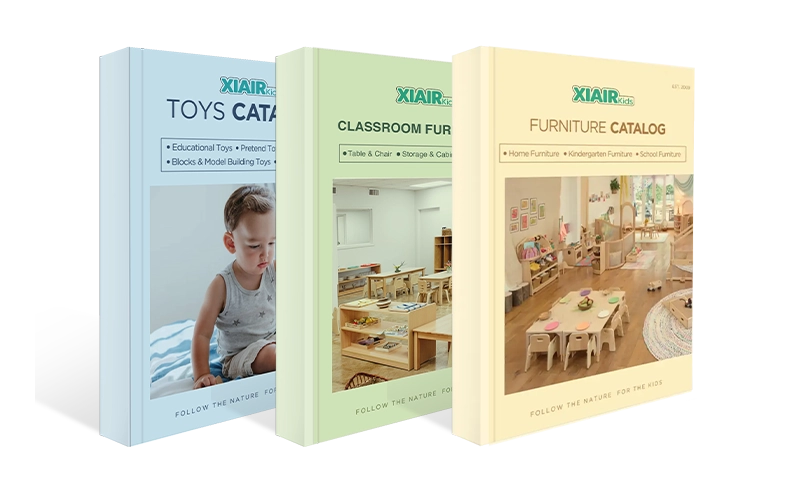
Receive a free catalog and custom layout to help you design your ideal classroom easily.
Non-verbal Communication
During parallel play, children begin to develop non-verbal communication skills. Even though they aren’t directly interacting, they learn to read facial expressions, body language, and other cues. For example, they might observe that another child is frustrated when their tower falls over, or that someone else is happy when they finish a puzzle. This type of observation helps children build empathy and understand others’ emotions.
Learning Boundaries and Personal Space
Through parallel play, children learn valuable lessons about boundaries and personal space. For example, a child playing with blocks might notice another child playing nearby and need to respect the other child’s space. While not directly interacting, children learn to navigate shared environments and understand the social norms of respecting others’ physical boundaries.
Understanding Group Dynamics
Another crucial social skill learned during parallel play is understanding group dynamics. Even though children may not directly engage in conversation, they begin to understand how their behavior affects others in the same space. For example, if one child takes a toy from another, the other child might express frustration, and the first child may recognize that their actions have caused an emotional response.
Learning these group dynamics through parallel play is foundational for moving into more complex game forms, such as cooperative play, where children share toys, negotiate, and work together towards a common goal.
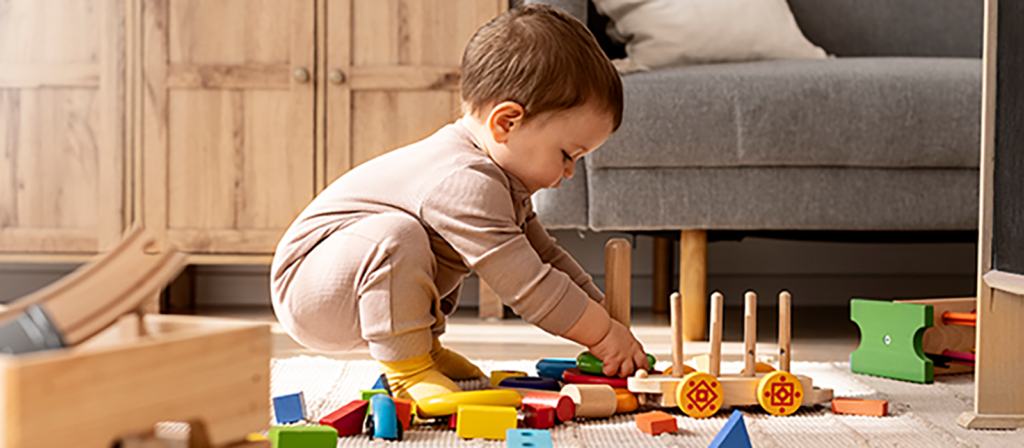
Mildred Parten’s social behavior theory and stages of play
Mildred Parten, a renowned sociologist and educator, developed an influential theory on children’s social behavior and their progression through different stages of play. Her research, conducted in the early 20th century, identified distinct phases in the development of play behavior as children grow and interact with their peers. According to Parten’s theory, children’s play evolves from solitary and independent activities to more complex, interactive group play forms. This process is crucial for social development, as each stage reflects a child’s increasing understanding of others, social skills, and ability to collaborate.
Parten categorized these stages into six key types of play, each of which marks a significant milestone in a child’s social and cognitive development. The stages she identified—unoccupied play, solitary play, onlooker play, parallel play, associative play, and cooperative play—illustrate how children’s play becomes progressively more social and collaborative as they age.
Unoccupied Play
Unoccupied play occurs in infants and young toddlers, typically from birth to about 2 years old. At this stage, children are not focused on any specific activity but rather explore their surroundings through random movements. While it may seem unstructured, this stage is crucial for sensory exploration and motor development. Infants experiment with objects and their bodies, learning cause and effect, and gaining essential skills that form the basis for more structured play in the future.
Solitary Play
By ages 2 to 3, children engage in solitary play, where they play alone without involving others. At this stage, children are intensely focused on their activities, whether building with blocks or engaging in imaginative play. While this may seem isolating, solitary play promotes independence, problem-solving, and creativity. Children in this stage also develop fine motor skills and become more aware of their preferences and interests.
Onlooker Play
Around ages 2 to 3, children begin onlooker play, observing other children playing but not participating. This stage is essential for learning by observation. Children gain an understanding of social dynamics, seeing how others interact, share, and follow rules. Though they are not yet actively involved, they begin to grasp the concept of group play and may feel encouraged to join over time.
Parallel Play
Children between the ages of 3 and 4 engage in parallel play, where they play side by side, often with similar toys, but do not interact directly. While children may not communicate, this stage is still vital for social development. They learn to respect others’ space, observe each other’s actions, and become aware of group dynamics. Though independent, children start learning from one another, which sets the foundation for later social cooperation.
Associative Play
By ages 4 to 5, children begin associative play, where they start interacting with others, sharing toys or ideas, but the play remains loosely structured. Though they still focus on their play, there is more communication and exchange. This stage introduces key social skills such as turn-taking and sharing. Children start forming friendships, conversing, and developing the social skills necessary for cooperative play.
Cooperative Play
Cooperative play typically emerges around age 5 and involves children playing together with a shared goal. This is the most advanced stage, where children coordinate roles, communicate, and collaborate. Whether building something together or playing a game, cooperative play fosters teamwork, problem-solving, and empathy. Children in this stage learn essential social skills, such as negotiation, conflict resolution, and understanding others’ perspectives.
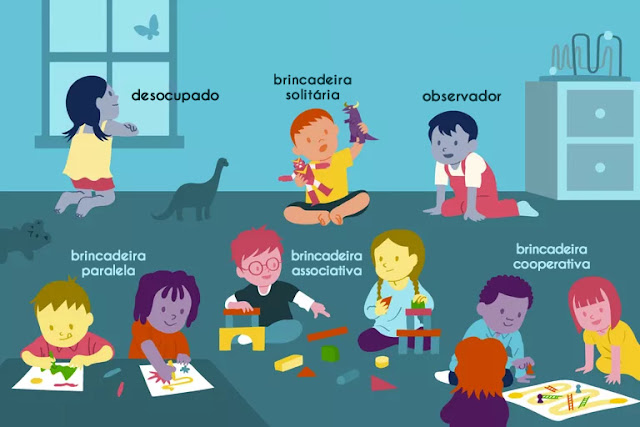
When Does Parallel Play Start and End?
Do toddlers play together, or just next to each other? When do they shift from side-by-side play to interactive fun? And what does this tell us about their social development? Parallel play typically starts around 18–24 months and can continue up to age 3 or even beyond, depending on the child’s developmental pace. It’s a critical stage that builds the foundation for future cooperative play.
This stage may seem simple on the surface, but there’s much more happening than meets the eye. Let’s dive into when parallel play begins and ends, and why it matters so much in early childhood education.
When Does Parallel Play Start?
Parallel play usually starts between 18 months and 2 years of age. At this age, toddlers are becoming increasingly mobile and curious about their environment. They notice other children but don’t yet have the communication skills or emotional regulation to fully interact. Instead, they find comfort in playing near others, using similar toys, or mimicking their behavior from a safe distance.
This developmental stage follows solitary play, which is common from 0 to 18 months. During solitary play, babies engage in self-directed activities such as shaking rattles, exploring objects with their mouths, or simply observing their environment. But as their brain develops, children become more interested in the actions of those around them.
Some indicators that a child has entered the parallel play stage include:
- Preferring to play near—not with—other children
- Imitating another child’s behavior (e.g., stacking blocks, pretending to cook)
- Having minimal direct communication with peers
- Using toys independently, but occasionally looking at others’ play
When Does Parallel Play End?
For most children, parallel play begins to fade around 30 to 36 months (2.5 to 3 years old), as they move into the next stages of social development: associative play and eventually cooperative play.
However, the exact timeline can vary. Some children may remain in the parallel play stage longer, especially if they are naturally introverted, have language delays, or are in environments with fewer peer interaction opportunities. Others, particularly those in rich social settings like daycares, Montessori classrooms, or sibling households, may begin transitioning earlier.
It’s important to observe behavior changes rather than just relying on age. Children don’t suddenly stop parallel play—they slowly begin to interact more intentionally with others:
- Increased verbal interaction: The child starts talking to peers while playing—even if it’s just short phrases like “My turn!” or “You do this.”
- Toy sharing and turn-taking: While still learning, they begin to offer or accept toys, a crucial part of associative and cooperative play.
- Engaging in role-play: Pretend play scenarios like “You be the doctor, I’ll be the nurse” indicate a shift toward imaginative and collaborative play.
- Awareness of others’ emotions and actions: Children begin responding to what others are doing or feeling, showing early empathy or curiosity.
- Playing with a common goal: Instead of just building blocks side by side, they might work together to build a castle or house.
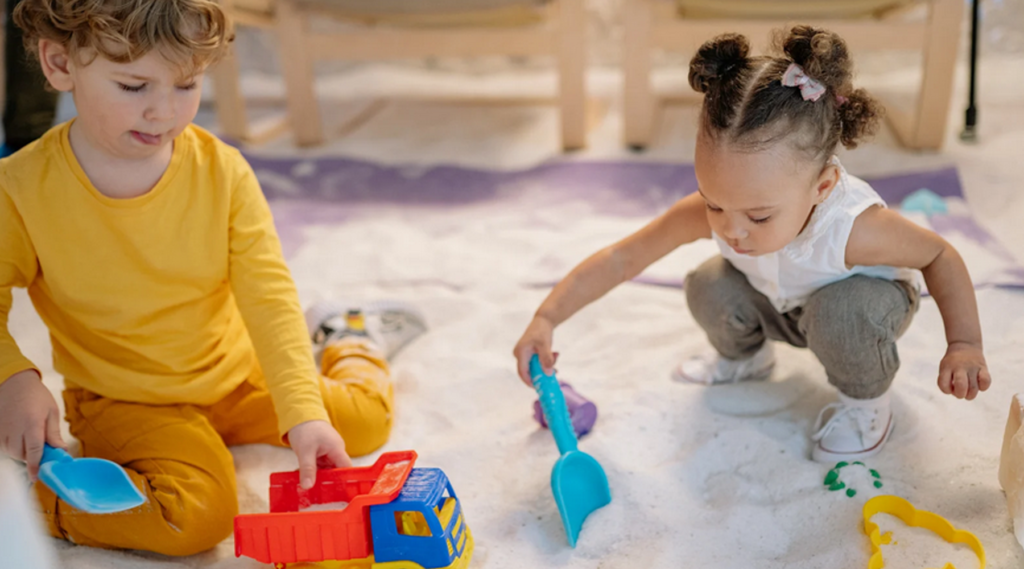
Why This Timeline Matters?
Understanding when parallel play starts and ends helps caregivers and early educators respond to each child’s needs without imposing social expectations too early. It also helps in designing play environments in kindergartens or Montessori classrooms. At TOP Montessoris, for example, we recommend arranging classrooms for toddlers (18 months to 3 years) with:
- Side-by-side activity zones
- Low open shelves for easy toy access
- Duplicated play materials (e.g., two sets of blocks or puzzles)
- Child-sized furniture that encourages independent use
Recognizing this timeline also prevents frustration. A child still engaged in parallel play is not being antisocial; they are simply building the base of social learning. Forcing cooperation too soon can lead to anxiety and social withdrawal.

Receive a free catalog and custom layout to help you design your ideal classroom easily.
Benefits of Parallel Play
Parallel play is an essential stage in child development that lays the foundation for various critical skills, including language acquisition, motor skills development, and social competencies. Though it may seem like children are simply playing alone next to each other, the benefits of parallel play go far beyond what meets the eye. This seemingly solitary play can support various growth areas, setting the stage for more advanced social interactions and independent skills in later life.
Supports Language Development
One of the most notable benefits of parallel play is its role in language development. When children engage in parallel play, even though they are not directly interacting with one another, they are still exposed to their peers’ language and communication styles. Observing other children and mimicking their verbal expressions allows children to enhance their language skills.
For instance, when a child sees another child naming objects while playing with blocks or toys, they pick up new vocabulary. Over time, these observational cues help children expand their vocabulary and improve their ability to form sentences. As children become more comfortable with parallel play, they may engage in spontaneous dialogue with their peers, initiating simple conversations and learning social cues like turn-taking in communication. Thus, parallel play is a stepping stone for developing more complex verbal interactions in cooperative play.
The benefits of parallel play in language development are particularly significant during the toddler years, when children rapidly acquire new words and learn to express their thoughts. This stage helps children understand the function of language in social interactions, an essential skill for their future development.
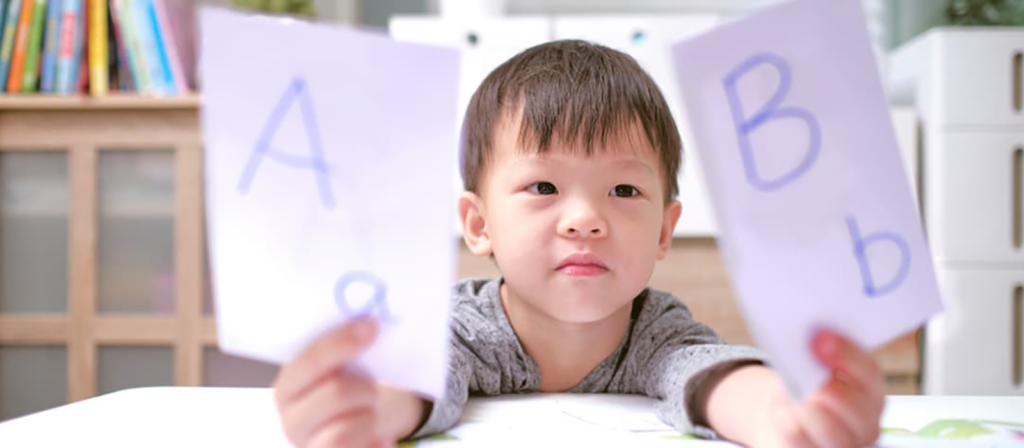

Receive a free catalog and custom layout to help you design your ideal classroom easily.
Promotes Gross and Fine Motor Skills Development
In addition to supporting language growth, parallel play is crucial for developing gross and fine motor skills. Whether a child is stacking blocks, drawing with crayons, or building a tower with toys, the physical act of playing contributes to the strengthening of various motor skills. These activities help children practice hand-eye coordination, refine their grip, and develop better control over their movements.
For example, children work on their fine motor skills by manipulating small objects in parallel play with building blocks or stacking cups. Similarly, activities like running, jumping, or playing catch with peers help develop gross motor skills, essential for physical coordination and overall health.
As children continue to engage in activities during parallel play, they also improve their muscle strength and spatial awareness. These physical abilities are crucial for play and day-to-day tasks such as dressing, eating, and writing as they age.
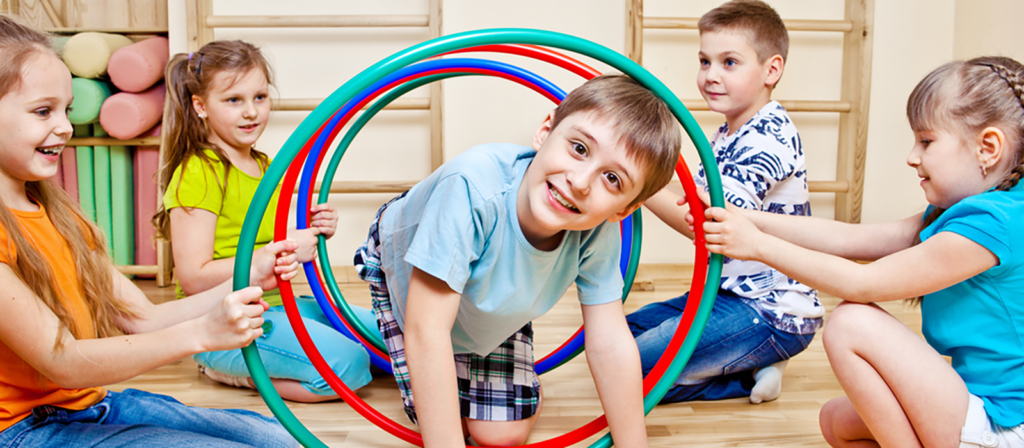
Facilitates Social Development
Parallel play is often seen as an initial step in developing social skills. While children are not interacting directly with one another, they are learning essential aspects of social development, such as how to respect personal space, observe social cues, and engage with others in a shared environment. This indirect social interaction helps children build the skills necessary for more complex relationships in the future.
Through parallel play, children learn the subtle art of non-verbal communication. They begin to understand body language, facial expressions, and the emotional states of their peers, which are crucial skills for emotional intelligence. Even though the play may seem isolated, children still observe how their peers react to situations and adjust their behavior accordingly. For example, suppose a child notices another child is upset because they lost a toy. In that case, they might start understanding empathy and learn how to respond appropriately in social situations.
Parallel play also gives children a sense of belonging. Although they are not interacting directly, simply being near other children and sharing the same space helps them feel connected to their peers. This early form of socialization is critical for building self-confidence and emotional security, which are the building blocks of positive future social relationships.
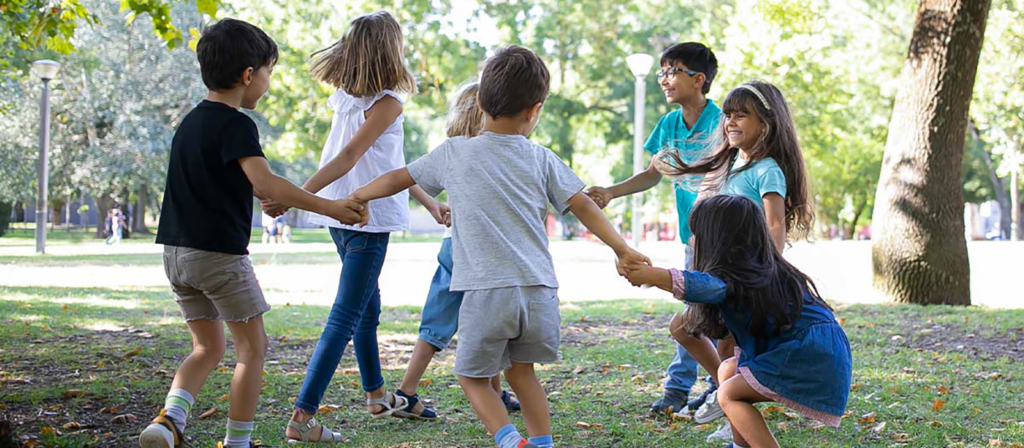

Receive a free catalog and custom layout to help you design your ideal classroom easily.
Fosters Collaboration and Sharing
One crucial benefit of parallel play is that it gradually fosters collaboration and sharing in young children. Although parallel play starts as a more solitary form of play, where children engage in similar activities next to each other without direct interaction, it sets the stage for children to learn how to work together in future social contexts. As children observe each other during parallel play, they begin to understand the concept of cooperation and the importance of sharing their toys or materials.
For instance, if two children are playing side by side with the same set of blocks, even though they are not interacting directly, they start to notice that one child is running out of blocks to build their tower. This observation might naturally lead one child to offer more blocks to their playmate, a key learning moment in social development. Parallel play provides a safe environment for children to practice taking turns and managing shared resources before moving on to more complex forms of play where collaboration is required.
At its core, parallel play teaches children that it’s not just about playing with their toys but learning to respect others’ space and materials. Even though they may not immediately engage with their peers, children observe the importance of mutual respect and understanding in shared play environments. This exposure helps them transition more smoothly into cooperative play, where collaboration and sharing skills are key to successful interactions. Over time, children will practice these skills more actively, learning to share toys, negotiate with peers, and engage in group activities like building a fort or playing a team game.
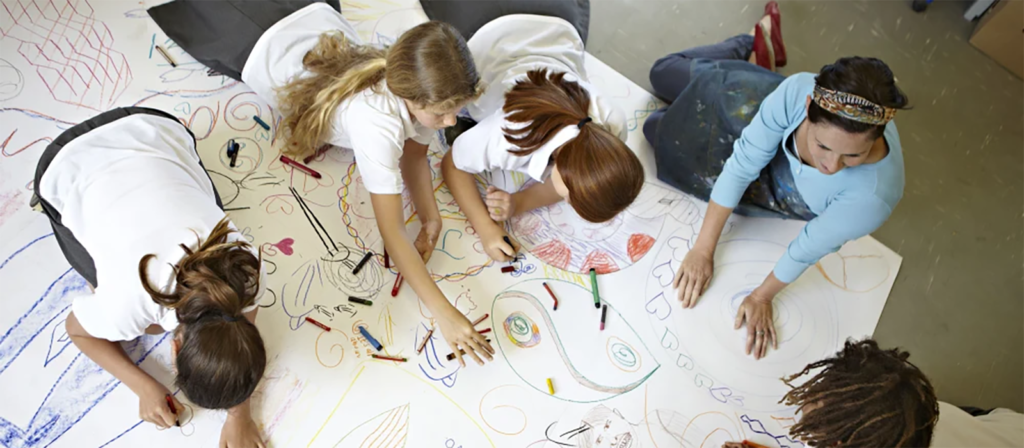
Encourages Independence
One of the most empowering aspects of parallel play is its ability to encourage independence in young children. During parallel play, children play side by side without needing constant guidance or involvement from an adult or peer. This freedom allows them to explore their interests, experiment with different toys, and decide how to engage in their activities—all fundamental to building independence.
For example, a child might engage in parallel play by playing with their blocks, focusing on building a structure independently. In this situation, the child learns to set goals, solve problems independently, and create something out of their imagination. While their playmate may be doing the same activity next to them, the child isn’t relying on others to guide their actions or validate their choices. This sense of autonomy builds confidence, as children learn that they are capable of figuring things out for themselves.
The ability to entertain oneself and focus on personal tasks during parallel play is an essential building block for emotional and cognitive independence. Children play independently and develop the skills necessary for self-regulation, such as patience, emotional control, and problem-solving. These are all vital tools for navigating the world as they age and face more complex situations.


Receive a free catalog and custom layout to help you design your ideal classroom easily.
What is Parallel Play in Child Development?
Parallel play is a developmental stage where children play alongside each other but do not interact directly. It’s often seen in toddlers and young children as they explore their interests and activities. Although parallel play might seem like solitary play, it is a vital component of child development, preparing children for more complex forms of social interaction and cooperative play as they grow.
Building with Blocks
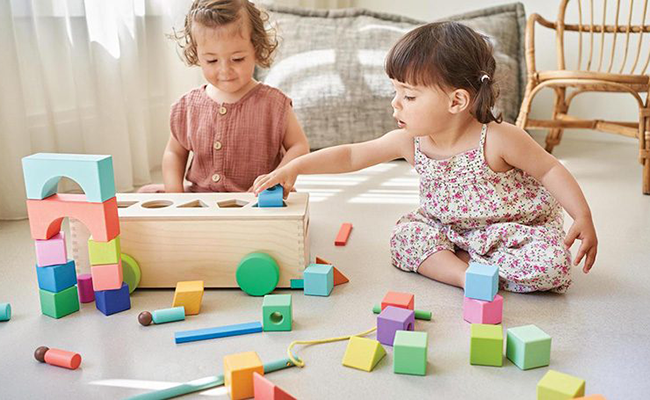
One classic example of parallel play is building with blocks. Children may sit next to each other, each constructing their tower or structure. They may use the same type of blocks, but not communicate directly. Through this activity, children engage in imaginative play, develop fine motor skills, and practice decision-making independently in the same play environment.
This form of parallel play allows children to focus on their tasks and create structures, which helps them build a sense of autonomy. Even though there is little interaction, the shared activity provides an implicit connection to others, assisting children in developing awareness of their peers’ actions and starting to learn about social boundaries.
Drawing or Coloring
Another example of parallel play is drawing or coloring. In this activity, children may sit beside each other and draw independently, without directly exchanging ideas or materials. This kind of parallel play allows children to explore creativity and express themselves without interference from others, all while developing essential fine motor skills such as holding a crayon or making controlled movements.

Through drawing or coloring, children practice concentration and develop hand-eye coordination. They may notice what their peers are drawing, which can inspire them and lead to mutual interest in similar topics. Over time, these activities help foster the foundation for more interactive, creative play.
Playing with Dolls or Action Figures

Playing with dolls or action figures is another example of parallel play. Children may sit beside each other, playing with their dolls or action figures, but not interacting. Although they are not engaging directly with each other, using similar toys creates a subtle sense of connection. Children develop creativity and role-playing skills while learning to understand their peers’ preferences and behaviors through observation.
This form of play helps children practice imaginative thinking and builds confidence as they control their play narratives. Over time, parallel play with dolls or action figures can transition into more interactive and social types of play.
Pretend Play with Play Kitchens or Tool Sets
A further example of parallel play is pretend play with toys such as kitchens or tool sets. Children might sit beside each other in this activity, pretending to cook or fix things with their tools. Though they are engaged in their independent role-play scenarios, the proximity of the other child allows them to observe and potentially mimic actions. For example, one child might pretend to serve food to their dolls, while the other pretends to bake cookies. Over time, the play may shift from independent role-playing to cooperative pretend scenarios where children begin to share roles, such as one child pretending to cook while the other serves food, marking the shift toward cooperative play.
Through this type of parallel play, children practice social interactions, learning to navigate the role of giving and receiving in play. They also build critical cognitive skills by engaging in complex pretend scenarios, which help develop their understanding of everyday activities, problem-solving, and emotional expression.
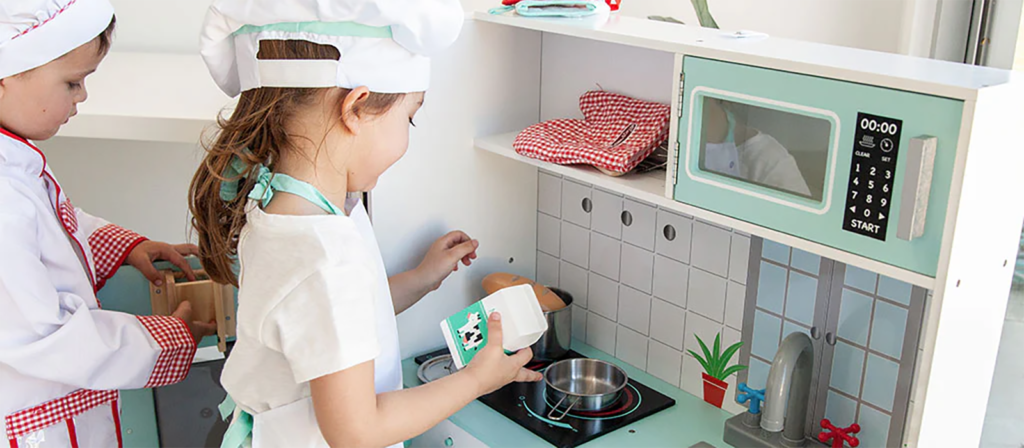
At What Age Does Parallel Play Start and Stop?
Parallel play typically starts around 18 months, though it can vary depending on the child’s development. This stage is common in toddlers, who begin to show more interest in playing near other children but without direct interaction. By age 3, children often shift from parallel play to more complex forms of cooperative play, where they start to share toys, take turns, and work together in play activities.
The age of parallel play can extend beyond the typical toddler years, especially in children still developing social skills. However, by age 5 or 6, most children will have transitioned into cooperative play, where interactions are more direct and involved. This transition is a natural progression in child development, marking the shift from independent to collaborative play.
The age range for parallel play varies from child to child, but most children engage in parallel play between 18 months and 3 years. As children grow and become more comfortable in social situations, they engage in more direct and interactive play, paving the way for more advanced social relationships and group play activities.

What is Parallel Play Autism?
Parallel play is an important developmental milestone for all children, but it can hold particular significance for children with autism. Parallel play autism refers to the way children on the autism spectrum engage in side-by-side play without direct interaction with others. Children with autism often find engaging in typical social exchanges, such as eye contact, verbal communication, or joint activities, challenging. However, parallel play allows these children to engage with their peers in a more comfortable, low-pressure environment.
During parallel play, children with autism can observe their peers, mimic behaviors, and learn from them without expecting direct interaction. This type of play allows children with autism to practice social skills in a non-threatening setting. It helps them understand the presence of others, manage their personal space, and begin to experience social interaction in small doses.
Parallel play autism is often the first step towards cooperative play, which can be more overwhelming for children with autism due to the need for reciprocal communication. Children may be more comfortable engaging with peers in parallel play because they don’t have to communicate or share directly. They can still benefit from the presence of others, which supports the development of empathy, social awareness, and emotional regulation.
For children with autism, parallel play provides several benefits, including:
- Reduced social anxiety: Children can observe their peers from a distance and learn social cues without the pressure of direct engagement.
- Building trust: Over time, children with autism may feel more comfortable with their peers, as they observe and understand how others behave.
- Improved focus: Because children with autism often benefit from routine and predictability, parallel play offers a structured environment to engage in repetitive or preferred activities.
While parallel play is crucial for children with autism, gradual shifts toward cooperative play must be encouraged as children gain confidence in social interactions. The goal is to build the necessary skills for more complex social play, helping autistic children learn to share, take turns, and work with others.

Receive a free catalog and custom layout to help you design your ideal classroom easily.
How Parents and Educators Can Support Parallel Play?
Supporting parallel play is essential for both typical children and those with autism. Parents and educators play a crucial role in fostering this type of play to ensure it is an effective stepping stone for future social interactions. Below are key strategies for how parents and educators can support and enhance parallel play for children.
Provide Space
The first step in fostering parallel play is to ensure children have the right environment. It’s important to provide space for children to engage in their play activities and be near others. This creates a comfortable environment where children are aware of each other’s presence but are not forced to interact. By setting up activities nearby, children can observe others without feeling overwhelmed or pressured into socializing. For children with autism, having the right amount of personal space can help them feel secure while still being part of the group.

Parents and educators can set up designated play areas, allowing children to engage in activities while respecting their space. This could include play mats, sensory corners, or activity stations where children can perform independent tasks near others without direct interaction.
Observe and Encourage
Parallel play provides a valuable opportunity for parents and educators to observe how children interact with one another, even if it’s from a distance. Parents and educators can identify specific interests, challenges, and preferences in the children’s play behavior by carefully observing. Once they observe a child engaging in parallel play, it’s essential to encourage these behaviors by acknowledging their engagement, even if the child isn’t directly interacting with others.
For instance, if a child is playing with blocks beside another child, praising their concentration or creativity can encourage them to continue playing alongside their peers. Positive reinforcement for non-interactive play can help children feel motivated to explore the social aspects of their environment at their own pace.
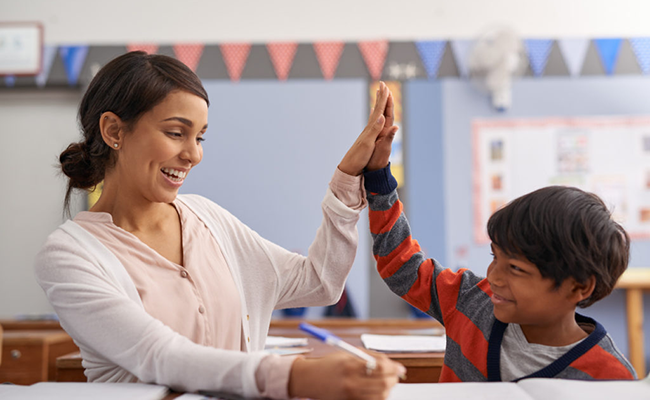
Model Social Behavior
Modeling appropriate social behavior is one of the most effective ways to encourage children to move from parallel to cooperative play. Parents and educators can model appropriate behaviors, such as taking turns, sharing toys, and using polite language, while children engage in side-by-side activities. By seeing adults engage in these behaviors, children are more likely to mimic them, gradually incorporating them into their play.
For example, if children play with dolls next to each other, an educator might ask, “Can I use this doll for a minute?” or “Would you like to share the toys?” Such modeling helps children understand the expectations for more interactive forms of play without forcing them into direct interaction right away.
Set Playdates
Playdates are an excellent way to encourage parallel play. Parents can arrange playdates with other children where the goal is not immediate interaction but the opportunity for children to engage side by side. Parents can observe how children interact during these playdates, even if they are not engaging directly. Playdates can be set up with activities such as building blocks, drawing, or pretend play, where children are likely to engage in parallel play.
Over time, children will become more comfortable in these settings, leading to the possibility of cooperative play as they get used to sharing and taking turns.
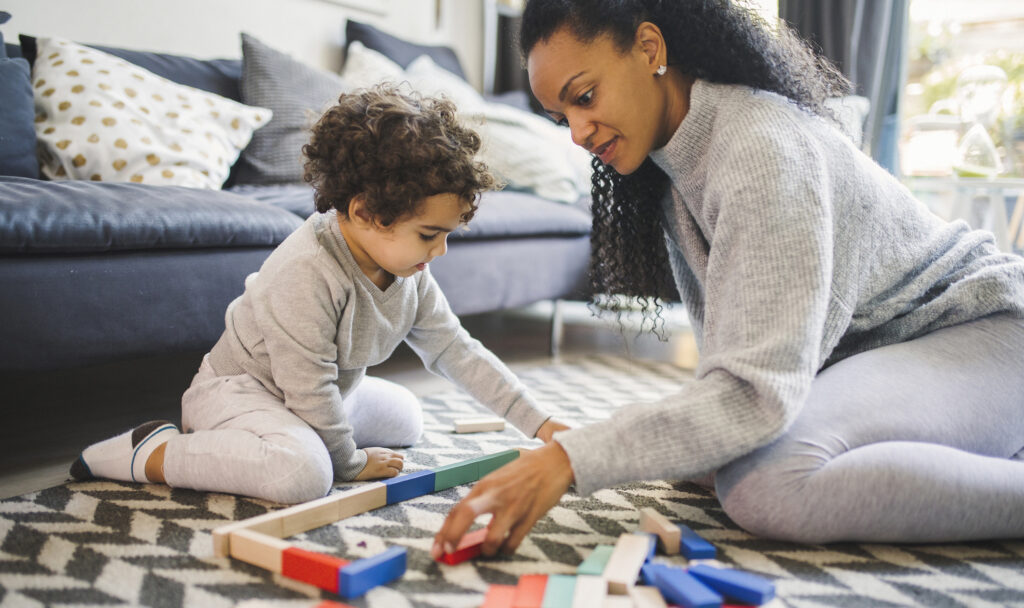
Incorporate Music and Dance
Incorporating music and dance into the play environment can also be an effective way to support parallel play, especially for children who are more sensory-sensitive or enjoy rhythm-based activities. Music allows children to engage with each other while still focusing on their movements. Parallel play with music might involve children dancing or clapping along to a song next to one another, but not necessarily interacting.
This type of sensory play fosters emotional expression and helps children develop coordination, rhythm, and social awareness. It also provides a non-verbal way to connect with peers and build a shared experience, which is crucial for gradually developing cooperative play.
Encourage Sensory Play Activities
Sensory play is particularly beneficial for children on the autism spectrum, as it provides a low-pressure environment for them to explore their senses and engage in play. Sensory activities—such as playing with sand, water, playdough, or textured toys—allow children to explore and interact with their environment without verbal communication. These activities promote tactile exploration, essential for sensory processing and emotional regulation.
By introducing sensory play activities, parents and educators can encourage parallel play in a fun, engaging, and beneficial way to meet a child’s developmental needs. Children often find comfort in sensory play, which helps them build confidence while interacting with others in a shared environment.
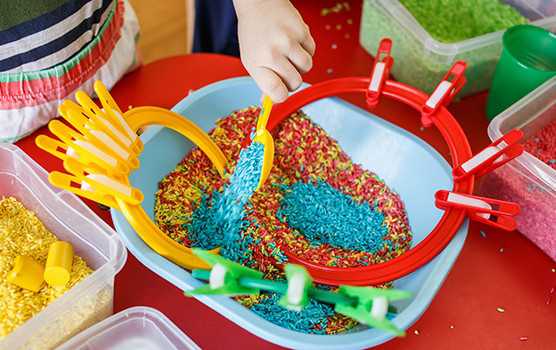
Provide More Toys
Sometimes, a simple solution to encouraging parallel play is offering a variety of toys or materials for children to use during their independent play. Providing a range of options ensures that children are not competing for the same resources, which may cause frustration. When each child has their own set of toys, they are more likely to focus on their play while still being aware of and engaged with the other child nearby.
Parents and educators can also set up different activity stations involving various sensory materials, puzzles, or creative toys, allowing children to engage in parallel play without feeling bored or restricted.

Receive a free catalog and custom layout to help you design your ideal classroom easily.
Create Themed Play Zones
Creating themed play zones can make parallel play more engaging and help children focus on specific activities. For instance, parents or educators can set up different sections of the playroom, each dedicated to a particular theme, such as a building zone with blocks, a kitchen area with pretend food, or a drawing area with markers and paper. Children are encouraged to engage in parallel play in a structured and stimulating environment by providing distinct spaces for different activities.
These themed play zones also allow children to explore different aspects of their creativity and imagination, allowing them to choose where to play and how to engage with the toys or materials.
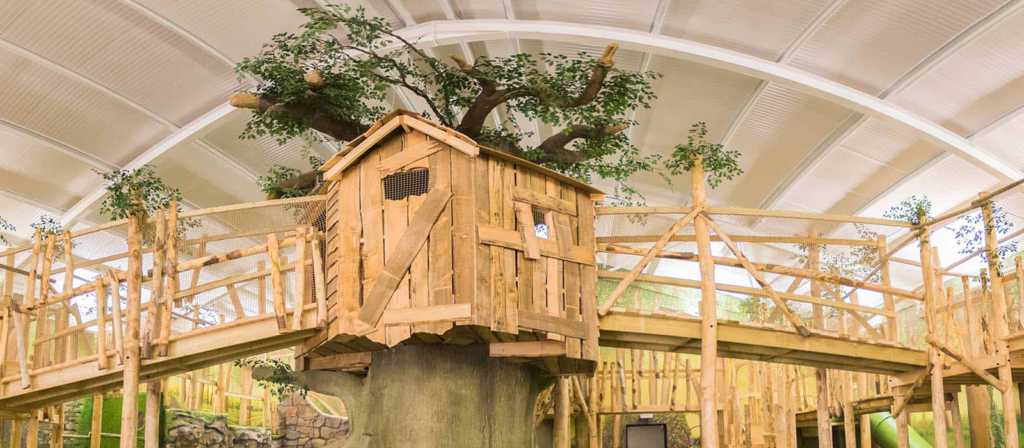
Parallel Play vs. Cooperative Play: Key Differences
To further understand parallel play, comparing it to cooperative play is helpful. The two stages are often linked in child development but represent different social interaction phases. The following table highlights the key differences between parallel play and cooperative play:
| Aspect | Parallel Play | Cooperative Play |
|---|---|---|
| Definition | Children play side by side without interacting. | Children engage in activities together, sharing and interacting. |
| Interaction | Limited or no direct interaction between children. | Frequent interaction, including communication and collaboration. |
| Age Range | Typically seen in toddlers (18 months to 3 years). | Usually begins around 3-4 years and increases with age. |
| Play Style | Independent play in close proximity. | Joint activities with shared goals or tasks. |
| Social Skills Development | Develops awareness of others and personal space. | Develops teamwork, sharing, and empathy. |
| Emotional Regulation | Helps children become comfortable with social settings. | Requires managing emotions in group dynamics. |
| Learning Focus | Focuses on individual exploration and imitation. | Focuses on collaboration, sharing, and working together. |
FAQs
1. Why is parallel play important for children with autism?
Parallel play helps children with autism observe and engage with peers without the pressure of direct interaction, gradually building social comfort and learning social cues.
2. How can parallel play help in the development of motor skills?
During parallel play, children improve their gross and fine motor skills and practice coordination and muscle control by engaging in activities like stacking blocks or drawing.
3. How does parallel play contribute to emotional regulation in toddlers?
Parallel play allows toddlers to manage their emotions independently, helping them learn how to cope with frustration and excitement in a controlled environment.
4. Can parallel play help with social anxiety in children?
Yes, parallel play creates a low-pressure setting for children with social anxiety, allowing them to become comfortable being around peers before engaging directly.
5. How can parents encourage parallel play at home for their children?
Parents can set up side-by-side play areas with toys like puzzles or building blocks, arrange playdates, and praise independent play to encourage parallel play at home.
Conclusion
In conclusion, parallel play is an essential stage in child development, providing a solid foundation for future social interactions. It fosters independence, creativity, and observational learning, all while preparing children for more complex forms of play, such as cooperative play. Parents and educators can support parallel play by creating a conducive environment, observing children’s behaviors, and encouraging safe social experiences.
Understanding parallel play—especially in children with autism—helps provide insight into how children develop their social and emotional skills. By embracing and supporting parallel play, we allow children the space to grow at their own pace, building the confidence and social abilities they need to thrive.







